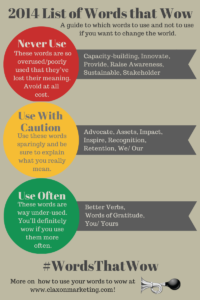 [This is part five of our 1, 2, 3 Marketing Tree Step-by-Step series, written by our fabulous intern, Vicki. If you’re new to the series, you can catch up on previous posts. If you haven’t already gotten 1, 2, 3 Marketing Tree, now is a great time to either buy the awesome poster-size version or download the free version, so you can follow along. You can find the free version in Claxon’s DIY tools a la carte menu or in the Marketing 101 Toolkit. You can buy the super spiffy poster here.]
[This is part five of our 1, 2, 3 Marketing Tree Step-by-Step series, written by our fabulous intern, Vicki. If you’re new to the series, you can catch up on previous posts. If you haven’t already gotten 1, 2, 3 Marketing Tree, now is a great time to either buy the awesome poster-size version or download the free version, so you can follow along. You can find the free version in Claxon’s DIY tools a la carte menu or in the Marketing 101 Toolkit. You can buy the super spiffy poster here.]
Your competition may not be who you think it is.
The next two questions on the 1,2,3 Marketing Tree are:
- Who, or what, is your competition?
- What makes you more compelling than your competition?
Before we can answer these questions, we need to ask another question.
What do you need?
Your organization requires many inputs from muffins for the staff meeting to grants for that new program you want to start. But, you are probably only worried about a small subset of inputs due to factors like a high impact on outcomes, supply shortages, or supply instability. Do you need clients? Funding? The attention of law-makers? When you want your voice to be heard, your biggest competition might be another nonprofit doing similar work. Then again, it might be the latest hit TV show.
Your local movie theater isn’t just worried about other cinemas. They are in competition with video games, putt-putt golf, that novel everyone is talking about, and all of the other things you might do with your free time this weekend.
The easiest way to think about competition is to step back from your own point of view and look at things from the point of view of the resource(s) you need and the people controlling that resource. Where else might the resources (e.g. money, time, energy) flow? That’s your competition.
Now think about the people making decisions about that flow. The potential volunteers deciding how to spend their time. The foundation manager designing metrics for grant evaluations. What factors are they considering as they make their decisions? Being more compelling than your competition is about being different in a way that impacts those decisions, i.e. in a way that inspires people pick you over the competition.
Who, or what, is Chirp’s competition?
Let’s turn to Chirp, the school for birds founded by Claxon’s mascot, Roxie. (Check out previous posts for the full back-story.)
As a reminder, Chirp needs to get more students into their classes. This means they need to be thinking about what else birds might choose to get involved in. They need to know who/what their competition is and what differentiates them from that competition.
Steve the Crow’s bird choir is another organization that draws birds in from multiple flocks for a culturally enriching pursuit. This is the obvious competition. Steep competition also exists, however, from other bird pastimes like digging for worms, swimming in ponds, and pooping on cars.
Like all of us, birds use their free time to engage in activities that they find fun and meaningful. Chirp believes it is both fun and meaningful AND is distinctive in that they offer an opportunity to communicate with other flocks. Within bird culture, however, loyalty is expressed through choosing to be like all of your fine, feathered friends. So, many birds make choices about their time by simply flocking together with birds of the same feather. For this reason, Chirp will also want to show that entering its program can be a fun group activity and tout the benefits the whole flock can glean from being able to communicate with other species. By speaking with other flocks, birds can learn about cats to avoid and bushes with ripe berries.
Albert the Owl has been doing some interesting linguistic studies and has found geographic patterns in the single word songs that different flocks are using. He is proud to be part of an organization that cares about supporting such research and expects his findings to impact the way words are taught to birds in other areas. Steve’s bird choir is not engaging in any research and Albert is at a loss as to how anyone could consider the two organizations even comparable. If Chirp were competing for grant funding, this would be a compelling. From the viewpoint of a student considering entering the school, however, Albert’s research isn’t likely to be something they would participate in. So, as interesting and important as it may be, it isn’t something that makes them compelling to those birds.
In sum…
As you are thinking about who your competition is, make sure you think outside of the nonprofit box. And, as you think about what makes you more compelling than your competition, make sure you are thinking beyond the differences that matter to you and focus on what matters to the people you’re looking to engage in your mission.
So far in this series, we have been talking about some big picture aspects of what your organization is about. As we focus in on what your marketing should be about, some strategic decisions have to be made. That’s what we’ll go over next week.




 I would maintain that thanks are the highest form of thought; and that gratitude is happiness doubled by wonder. ~G.K. Chesterton
I would maintain that thanks are the highest form of thought; and that gratitude is happiness doubled by wonder. ~G.K. Chesterton In the nonprofit world, this is a common scenario: Your small or new organization has an amazing mission that you want everyone to know about. However, you’ve never had a designated marketing person. A volunteer, intern or staff member offers to give it a go. But where do they start?
In the nonprofit world, this is a common scenario: Your small or new organization has an amazing mission that you want everyone to know about. However, you’ve never had a designated marketing person. A volunteer, intern or staff member offers to give it a go. But where do they start?
